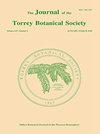1963年至2000年新泽西皮埃蒙特地区弗吉尼亚杜松的生长速率、存活率和性别比
IF 0.8
4区 生物学
Q4 PLANT SCIENCES
引用次数: 7
摘要
QUINN, J. A.(罗格斯大学生态、进化和自然资源系,新不伦瑞克,新泽西州08901-1582)和S. J. Meiners(东伊利诺伊大学生物科学系,查尔斯顿,伊利诺伊州61920-3099)。1963年至2000年新泽西皮埃蒙特地区弗吉尼亚杜松的生长速率、存活率和性别比。托里·博特。社会科学,131:187-194。2004.对雌雄异株物种的生长、存活和性别比的研究主要是短期的。本研究调查了1963年至2000年间弗吉尼亚杜松群的生长率、存活率和性别比例。本文以John Small从1963年到1976年收集的被标记新兵的身高和性别表达的初始数据为基础,对新泽西州皮埃蒙特地区6个不同年龄的老田野的男性(M)和女性(F)进行了分析。这些工厂在2000年夏季和秋季被重新安置并进行了普查。1976年至2000年间,性别表达没有变化。总体性别比接近1:1 (333 M, 332 F);只有一个字段显示明显偏离1:1。雄性的身高比雌性长得稍快,但明显快,但一旦进入繁殖阶段,雄性和雌性的相对生长率都下降了大约50%。在第一次繁殖时,雌树比雄树平均高23厘米(且年龄大)。存活至2000年的男女株高差异不显著。个体的性别对其死亡的可能性没有影响,但较晚形成的植物较短,通常不能繁殖,死亡的风险也更高。这些长期研究结果有力地支持了基因决定的性别比例,以及雄性和雌性在生长速度和存活率方面缺乏重大差异,这是在其他物种范围内进行的单年研究所提出的。本文章由计算机程序翻译,如有差异,请以英文原文为准。
Growth rates, survivorship, and sex ratios of Juniperus virginiana on the New Jersey Piedmont from 1963 to 2000
QUINN, J. A. (Department of Ecology, Evolution, and Natural Resources, Rutgers University, New Brunswick, NJ 08901-1582) and S. J. Meiners (Department of Biological Sciences, Eastern Illinois University, Charleston, IL 61920-3099). Growth rates, survivorship, and sex ratios of Juniperus virginiana on the New Jersey Piedmont from 1963 to 2000. J. Torrey Bot. Soc. 131: 187-194. 2004.-Studies of the growth, survival, and sex ratios of dioecious species have been predominantly short-term. This research investigated growth rates, survivorship, and sex ratios among cohorts of Juniperus virginiana L. from 1963 through 2000. Males (M) and females (F) in six old-fields of different ages on the New Jersey Piedmont were analyzed, starting with the initial data on height and sex expression collected by John Small on labeled recruits from 1963 through 1976. These plants were relocated and censused during the summer and fall of 2000. No changes in sex expression were recorded between 1976 and 2000. The overall sex ratio was almost 1:1 (333 M, 332 F); only one of the fields showed a significant departure from 1:1. Males grew slightly, but significantly, faster in height than females, but relative growth rates dropped by approximately 50% for both males and females once they became reproductive. Female trees were on average 23 cm taller (and older) than males at first reproduction. Heights in those males and females surviving to 2000 were not significantly different. There was no effect of an individual's sex on its likelihood of dying, but plants that became established later were shorter, often non-reproductive, and had an increased risk of mortality. These long-term results strongly support genetically-determined sex ratios and a lack of major differences between males and females in growth rates and survival, which had been suggested by single-year studies elsewhere in the species' range.
求助全文
通过发布文献求助,成功后即可免费获取论文全文。
去求助
来源期刊
CiteScore
0.70
自引率
0.00%
发文量
16
审稿时长
>12 weeks
期刊介绍:
The Journal of the Torrey Botanical Society (until 1997 the Bulletin of the Torrey Botanical Club), the oldest botanical journal in the Americas, has as its primary goal the dissemination of scientific knowledge about plants (including thallopyhtes and fungi). It publishes basic research in all areas of plant biology, except horticulture, with an emphasis on research done in, and about plants of, the Western Hemisphere.

 求助内容:
求助内容: 应助结果提醒方式:
应助结果提醒方式:


